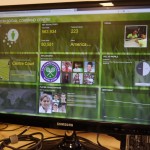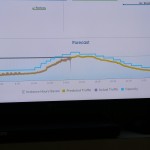Last week I was privileged to be invited behind the scenes to IBM’s Social Media Command Centre at Wimbledon to see how cloud, social and mobile technology can combine to make a really significant impact for everyone involved in one of the premier World sporting events of the year. I actually spent 2 or 3 hours talking to people and looking at an array of state of the art software solutions in “the bunker”, accessed from the basement of the broadcast centre right under some of the Wimbledon tennis courts. I must thank Andrew Grill, IBM’s Global Partner, Social Business who invited me, and Sam Seddon, the IBM Client Executive for Wimbledon, who showed me around. I did get to see some great Tennis from Nick Kyrgios and Eugenie Bouchard (two stars of the future!) while I was there, but being a Tennis fan was secondary to the rather awesome, geeky stuff underground.
 Sam has a team of around 200 supporting Wimbledon using an impressive array of terminals and technology on site, supplemented by an enormous amount of Cloud compute power from data centres in Amsterdam and the USA. They are providing a service to the All England Lawn Tennis Club to help make Wimbledon the premier sporting event, but in doing so they are serving the audience at the ground, fans around the World, the radio and TV broadcasters of the event, the event sponsors, the Club itself, and even the players directly.
Sam has a team of around 200 supporting Wimbledon using an impressive array of terminals and technology on site, supplemented by an enormous amount of Cloud compute power from data centres in Amsterdam and the USA. They are providing a service to the All England Lawn Tennis Club to help make Wimbledon the premier sporting event, but in doing so they are serving the audience at the ground, fans around the World, the radio and TV broadcasters of the event, the event sponsors, the Club itself, and even the players directly.
On each court they have experienced tennis players with special terminals collecting near real time data of each match, point by point – 3 on Centre and number 1 court, down to 1 person on the outside courts. They need a tennis savvy operator to differentiate a forced error from an unforced error and that kind of thing. On courts where Hawk-Eye technology is used they take a direct feed from that too. This year, for the first time, they are tracking the speed of the ball, how near it bounces to the line, how far a player is pulled out of position so they can classify aggressive play versus passive play. They manage all of the video feeds from every court and add data feeds to them for external broadcasters. They take social media data from Twitter’s Gnip feed – this is the “firehose” of data that gives them batches of geotagged Tweets every 5 minutes which can be tracked to their country of origin, or right down to the actual court within Wimbledon itself. On top of that they have all of the historical data collected on every player and every match during the 25 years they have working with Wimbledon, plus the club data going back to the very start of the event.
I spoke with Chris Thomas, Solution Architect – Big Data and Analytics at IBM, who is the guy in charge of the team and analytic technology making sense of this huge mass of social and digital raw material. They use IBM Watson Content Analytics and other software components to provide the club, broadcasters and other users a dashboard with 9 views – Evolving Topics, Key Social Statistics, Visual, Social Court, Influencers, Hill vs The World, Geolocation, Player Conversations, and Sentiment. Chris has created a collection of simple but powerful queries which then provide a visualisation of what is happening, and trends over time. From the dashboard a user can dive in to the detail, and then track back through the history to a Tweet conversation on particular date/time or to player statistics at previous tournaments right back to the start. All incredibly impressive and in terms of business analytics or social media monitoring this is deep functionality, directly applicable to just about any business.
They track Tweets by geography and can see how a particular social media conversation goes viral, and spreads country by country over time. They can see who are the most influential on Twitter, be it players, fans, journalists or pundits, and track the engagement around particular players, matches or specific incidents happening in real time. They look at timeliness, authority, followers, and global reach. For example, one Tweet from Roger Federer was retweeted 1,520 times within 30 minutes. Each tweet from the Gnip feed contains a lot of meta-data. They track time, latitude, longitude, sentiment, the relative volume from that location and filter by player. There are bursts of activity they need to handle – in the final they will be collecting 6-700 Wimbledon related tweets a second! In terms of sentiment analysis, Watson uses natural language processing to help them identify, understand and categorise things properly. As well as tracking players and fans they have introduced a couple of new concepts this year. The Social Court assigns tweets to a particular court and shows the user when something special is happening. Hill versus The World is a great new idea. The audience sitting on Wimbledon’s Henman Hill, Murray Mound or whatever you call it can be asked questions on the big screen. The same questions get asked on social media around the World. Then they track the difference in sentiment and engagement between the audience on the hill in the ground versus the audience in the rest of the World. They’ve also added a visual feed, from trusted photographic sources, which provides extra player and fan related content for the users. They’re being very cautious with this as Wimbledon.com and the AELTC can only be described as conservative when it comes to some of the images people put out there!
Chris’s team provide the dashboard to users on site, XML feeds out to the World, data feeds that combine with video for the broadcasters, and feeds that go directly to the Wimbledon.com website and the Wimbledon mobile app. IBM provide the website and the app, and you should compare Wimbledon to other tournaments and Grand Slams around the World. As a Tennis fan I have no doubt that the site and app have by far the best user experience for finding your way around and answering the key questions about a particular player, where they are at in the draw, order of play and the like. They do the basics right, but then add a huge amount of great content on top of that.
 I spoke to Alexandra Willis, the Club’s Editorial Content Manager. She is probably the key customer being served by that analytics dashboard. She uses it to make real time decisions on what content she should be providing to the website, the mobile app, and Live @ Wimbledon – their on site radio and TV channel that also gets published on the website. It helps her spot problems that might be happening, say, in the queue or around the ground so they can be actioned. She can spot an incident happening which might be a great opportunity to pull in one of the sponsors for more exposure or to help solve an issue. They want to do much more than just recycling Tweets on a screen (which is the social media “monitoring” norm for so many events). She is particularly delighted with how she can use Hill versus The World, or use the visual feed to pull in fan photos from around the ground (and elsewhere) to add another dimension to their content. The day I was there there was a still lot of buzz about Shaquille O’Neal (who doesn’t tweet much, and didn’t at all from Wimbledon) but he was on centre court the day before. Actually the tweet buzz had been generated by an Andy Murray BBC article about meeting him the day before, but just published that morning. Alex tracks activity, events and sentiment like that by country – so far America has been the most engaged social media audience from day one and the male players get significantly more attention than the females. She uses the reports produced by IBM around share of the voice to feed the Live @ Wimbledon channel and help serve the audience, fans, her sponsors and the club to keep her event right on top.
I spoke to Alexandra Willis, the Club’s Editorial Content Manager. She is probably the key customer being served by that analytics dashboard. She uses it to make real time decisions on what content she should be providing to the website, the mobile app, and Live @ Wimbledon – their on site radio and TV channel that also gets published on the website. It helps her spot problems that might be happening, say, in the queue or around the ground so they can be actioned. She can spot an incident happening which might be a great opportunity to pull in one of the sponsors for more exposure or to help solve an issue. They want to do much more than just recycling Tweets on a screen (which is the social media “monitoring” norm for so many events). She is particularly delighted with how she can use Hill versus The World, or use the visual feed to pull in fan photos from around the ground (and elsewhere) to add another dimension to their content. The day I was there there was a still lot of buzz about Shaquille O’Neal (who doesn’t tweet much, and didn’t at all from Wimbledon) but he was on centre court the day before. Actually the tweet buzz had been generated by an Andy Murray BBC article about meeting him the day before, but just published that morning. Alex tracks activity, events and sentiment like that by country – so far America has been the most engaged social media audience from day one and the male players get significantly more attention than the females. She uses the reports produced by IBM around share of the voice to feed the Live @ Wimbledon channel and help serve the audience, fans, her sponsors and the club to keep her event right on top.
The players aren’t ignored in all of this. I met some of the many young and enthusiastic, IBMers in their twenties who put themselves forward to a heavily oversubscribed list to come and support the event. They have relaxed periods where they can hang around and watch tennis, but at the end of each allotted match they dive in to action for an intense half an hour of work. They edit all of the match footage for the player, and collate all of the match statistics and social media data on to memory stick, which they have to get to that player within 30 minutes of the end of the match. The player can then track back to particular points in the match, see what was going on, their errors, how aggressively they were playing or not, and learn from it to prepare for the next match.
 Here are my Flickr photos of the bunker, with all of the kit and example screen displays. IBM install a lot of equipment on site for the two week event, but the lion’s share of the horsepower required to drive the website, the dashboards and the underlying analytics come from the Cloud. Much of the Social Media monitoring is handled by Softlayer, supported from Data Centres in the Netherlands. The compute power for the website and the analytics comes from 3 data centres in the USA. This photo shows the monitoring screen in the command centre where the actual capacity used is being tracked, then a prediction of what capacity required is being calculated, and then the blue line above those two shows the actual resources that are in place so that the operators ramp up the capacity in line with peaks well before they happen. A fine example of what is behind elastic computing in practice.
Here are my Flickr photos of the bunker, with all of the kit and example screen displays. IBM install a lot of equipment on site for the two week event, but the lion’s share of the horsepower required to drive the website, the dashboards and the underlying analytics come from the Cloud. Much of the Social Media monitoring is handled by Softlayer, supported from Data Centres in the Netherlands. The compute power for the website and the analytics comes from 3 data centres in the USA. This photo shows the monitoring screen in the command centre where the actual capacity used is being tracked, then a prediction of what capacity required is being calculated, and then the blue line above those two shows the actual resources that are in place so that the operators ramp up the capacity in line with peaks well before they happen. A fine example of what is behind elastic computing in practice.
So the Wimbledon tennis, atmosphere, strawberries and cream were all great, I was more impressed by IBM’s Social Media Command Centre. It’s a real showcase of how the latest technology can be applied to add real value for all of the stakeholders in an organisation. It happens to be supporting a sporting event, but the key messages are generally applicable.
(Disclosure: IBM provided me access to the Ground and a fine Court 1 ticket, but no other expenses/fees)

David, It was a pleasure to host you at Wimbledon and this is a fantastic post, thanks again for taking the time to visit. The insights here put into perspective the scale of the IBM involvement at Wimbledon.
Andrew Grill
@AndrewGrill
Global Partner, Social Business
IBM